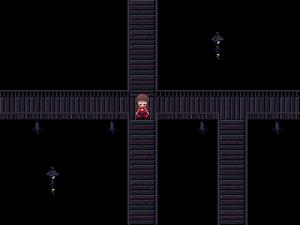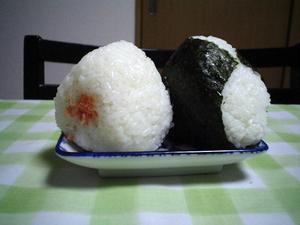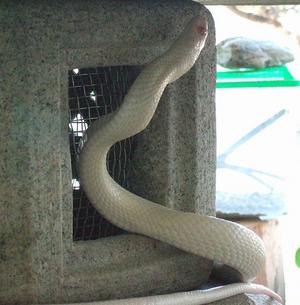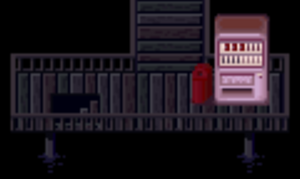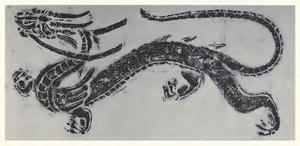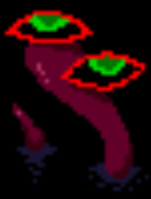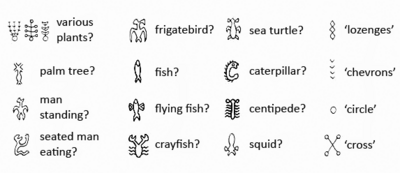>Mt.kiki No edit summary |
mNo edit summary |
||
| (55 intermediate revisions by 5 users not shown) | |||
| Line 1: | Line 1: | ||
[[File:Dock.jpg|link=http://yumenikki.wikia.com/wiki/The_Docks|frame|left|The Dock(A bridge in Uji)]] | [[File:Dock.jpg|link=http://yumenikki.wikia.com/wiki/The_Docks|frame|left|The Dock(A bridge in Uji)]] | ||
| Line 36: | Line 34: | ||
[[File:Masasumi_Hashihime.jpg|thumb|Hashihime as appearing in the Kyōka Hyaku-Monogatari from 1853]] | [[File:Masasumi_Hashihime.jpg|thumb|Hashihime as appearing in the Kyōka Hyaku-Monogatari from 1853]] | ||
==[[The Docks]]([http://en.wikipedia.org/wiki/Hashihime The maiden of the bridge])== | ==[[Yume Nikki:The Docks|The Docks]]([http://en.wikipedia.org/wiki/Hashihime The maiden of the bridge])== | ||
Hashihime <span style="font-weight: normal;">(橋姫<sup>[http://en.wikipedia.org/wiki/Help:Installing_Japanese_character_sets <span class="t_nihongo_icon" style="font: bold 80%/normal sans-serif; padding: 0px 0.1em; color: rgb(0, 0, 238); text-decoration: none; font-size-adjust: none; font-stretch: normal;"><u>?</u></span>]</sup>)</span> ("the maiden of the bridge"<sup class="reference" id="cite_ref-shikibu_1-0">[http://en.wikipedia.org/wiki/Hashihime#cite_note-shikibu-1 <u>[1</u>]]</sup>) is a character that first appeared in [http://en.wikipedia.org/wiki/Japan <u>Japanese</u>] [http://en.wikipedia.org/wiki/Heian <u>Heian</u>]-period literature, represented as a woman who spends lonely nights waiting for her lover to visit, and later as a fierce “oni” or demon fueled by jealousy. She came to be associated most often with a bridge in [http://en.wikipedia.org/wiki/Uji <u>Uji</u>]. | Hashihime <span style="font-weight: normal;">(橋姫<sup>[http://en.wikipedia.org/wiki/Help:Installing_Japanese_character_sets <span class="t_nihongo_icon" style="font: bold 80%/normal sans-serif; padding: 0px 0.1em; color: rgb(0, 0, 238); text-decoration: none; font-size-adjust: none; font-stretch: normal;"><u>?</u></span>]</sup>)</span> ("the maiden of the bridge"<sup class="reference" id="cite_ref-shikibu_1-0">[http://en.wikipedia.org/wiki/Hashihime#cite_note-shikibu-1 <u>[1</u>]]</sup>) is a character that first appeared in [http://en.wikipedia.org/wiki/Japan <u>Japanese</u>] [http://en.wikipedia.org/wiki/Heian <u>Heian</u>]-period literature, represented as a woman who spends lonely nights waiting for her lover to visit, and later as a fierce “oni” or demon fueled by jealousy. She came to be associated most often with a bridge in [http://en.wikipedia.org/wiki/Uji <u>Uji</u>]. | ||
[[File:Dock.jpg|thumb|The Dock,There in the middle of the night.]] | [[File:Dock.jpg|thumb|The Dock,There in the middle of the night.(from 1:00 a.m. to at the 3:00 a.m. time)]] | ||
[http://en.wikipedia.org/wiki/Hashihime Japanese literature] | [http://en.wikipedia.org/wiki/Hashihime Japanese literature] | ||
| Line 51: | Line 49: | ||
Hashihime’s name also appears in [http://en.wikipedia.org/wiki/Murasaki_Shikibu <u>Murasaki’s</u>] ''[http://en.wikipedia.org/wiki/The_Tale_of_Genji <u>The Tale of Genji</u>]'', as the title of a chapter. She is also mentioned several times in the [http://en.wikipedia.org/wiki/Waka_(poetry) <u>waka</u>] poems throughout the work. | Hashihime’s name also appears in [http://en.wikipedia.org/wiki/Murasaki_Shikibu <u>Murasaki’s</u>] ''[http://en.wikipedia.org/wiki/The_Tale_of_Genji <u>The Tale of Genji</u>]'', as the title of a chapter. She is also mentioned several times in the [http://en.wikipedia.org/wiki/Waka_(poetry) <u>waka</u>] poems throughout the work. | ||
==[[ | ==[[Yume Nikki:Strober|Sotoburu]]([http://ja.wikipedia.org/wiki/%E4%B8%91%E3%81%AE%E5%88%BB%E5%8F%82%E3%82%8A 丑の刻参り])== | ||
[http://ja.wikipedia.org/wiki/%E6%A9%8B%E5%A7%AB#.E5.AE.87.E6.B2.BB.E3.81.AE.E6.A9.8B.E5.A7.AB <u>2 宇治の橋姫</u>] [http://ja.wikipedia.org/wiki/%E6%A9%8B%E5%A7%AB#.E4.B8.91.E3.81.AE.E5.88.BB.E5.8F.82.E3.82.8A <u>2.3 丑の刻参り</u>] 2 Hashihime of Uji 2.3 丑の刻 (from 1:00 a.m. to at the 3:00 a.m. time) to a temple. | |||
<p class="rellink" style="font-style: italic; margin-left: 2em;">詳細は「[http://ja.wikipedia.org/wiki/%E4%B8%91%E3%81%AE%E5%88%BB%E5%8F%82%E3%82%8A <u>丑の刻参り</u>]」を参照</p> | |||
橋姫が行なった呪いの儀式が、[http://ja.wikipedia.org/wiki/%E4%B8%91%E3%81%AE%E5%88%BB%E5%8F%82%E3%82%8A <u>丑の刻参り</u>]のルーツである。 | |||
=====it is reference about '''"丑の刻(1:00-3:00 a.m.)"''' for details.<br />the ceremony of the curse which '''橋姫(Hashihime) performed is a root of 丑の刻.'''===== | |||
==[[Yume Nikki:Effects#Fat / Fatten(ふとる)|Fat]]([http://ja.wikipedia.org/wiki/%E8%85%B9%E6%99%82%E8%A8%88 腹時計] - A Stomach [http://en.wikipedia.org/wiki/CLOCK CLOCK])== | |||
'''腹時計'''(はらどけい)は、[http://ja.wikipedia.org/wiki/%E9%96%93%E8%84%B3 <u>間脳</u>]に存在する[http://ja.wikipedia.org/wiki/%E8%A6%96%E5%BA%8A%E4%B8%8B%E9%83%A8 <u>視床下部</u>]背内側核により、食事の周期に合わせ[http://ja.wikipedia.org/wiki/%E6%99%82%E8%A8%88%E9%81%BA%E4%BC%9D%E5%AD%90 <u>時計遺伝子</u>]が働き周期的に食欲が齎される現象。 | |||
A stomach clock is a phenomenon in which it unites with the cycle of a meal, a clock gene works by the dorsomedial hypothalamic nucleus which exists in a diencephalon, and appetite is brought about periodically. | |||
[[File:Fat(Belly-CLOCK).png|thumb|The metaphor to the clock of being able to expect a great portion of present time in the liking condition of the belly?]] | |||
==Fat([http://ja.wikipedia.org/wiki/%E3%81%8A%E3%82%84%E3%81%A4 おやつ] - [http://en.wikipedia.org/wiki/Snack Snack])== | |||
元々は八つ時(午後2時頃)に食べる間食の事であったが、'''間食'''の事を「おやつ」と呼ぶようになっていった<sup class="reference" id="cite_ref-1">[http://ja.wikipedia.org/wiki/%E3%81%8A%E3%82%84%E3%81%A4#cite_note-1 <u>[1</u>]]</sup>([http://ja.wikipedia.org/wiki/%E3%81%8A%E3%82%84%E3%81%A4#.E8.AA.9E.E6.BA.90 語源]を参照)。 | |||
Although it was the between-meal snack eaten from the first at eight o'clock (around the 2:00 p.m. time), it came to call a between-meal snack a "snack" [1] (see the # origin of a word). | |||
[http://ja.wikipedia.org/wiki/%E3%81%8A%E3%82%84%E3%81%A4#.E8.AA.9E.E6.BA.90 <u>2 語源</u>] [http://ja.wikipedia.org/wiki/%E3%81%8A%E3%82%84%E3%81%A4#3.E6.99.82.E3.81.AE.E3.81.8A.E3.82.84.E3.81.A4 <u>2.1 3時のおやつ</u>] (2 Origin of a word 2.1 Snack at 3:00) | |||
現在一般的には、午後の間食は午後3時前後とされる事がある。 | |||
=====Generally an afternoon between-meal '''snack may be carried out around 3:00 p.m.''' now.===== | |||
※丑の刻(1:00-3:00 a.m.) and 未の刻(1:00-3:00 p.m.) | |||
午前2時・・・丑(うし)の刻・・・八つ | |||
午後2時・・・未(ひつじ)の刻・・八つ | |||
http://e-walking.net/es/es124.html | |||
==Sotoburu([http://ja.wikipedia.org/wiki/%E6%A9%8B%E5%A7%AB Hashihime])== | |||
[http://ja.wikipedia.org/wiki/%E6%A9%8B%E5%A7%AB#.E5.AE.87.E6.B2.BB.E3.81.AE.E6.A9.8B.E5.A7.AB <u>2 宇治の橋姫</u>] [http://ja.wikipedia.org/wiki/%E6%A9%8B%E5%A7%AB#.E6.96.87.E7.8C.AE <u>2.1 文献</u>] [http://ja.wikipedia.org/wiki/%E6%A9%8B%E5%A7%AB#.E5.B9.B3.E5.AE.B6.E7.89.A9.E8.AA.9E <u>2.1.2 平家物語</u>] | [http://ja.wikipedia.org/wiki/%E6%A9%8B%E5%A7%AB#.E5.AE.87.E6.B2.BB.E3.81.AE.E6.A9.8B.E5.A7.AB <u>2 宇治の橋姫</u>] [http://ja.wikipedia.org/wiki/%E6%A9%8B%E5%A7%AB#.E6.96.87.E7.8C.AE <u>2.1 文献</u>] [http://ja.wikipedia.org/wiki/%E6%A9%8B%E5%A7%AB#.E5.B9.B3.E5.AE.B6.E7.89.A9.E8.AA.9E <u>2.1.2 平家物語</u>] | ||
| Line 87: | Line 123: | ||
[[File:Sotoburu_White.png|thumb|Sotoburu "White" Flash?]]綱はあわてず、鬚切で鬼の腕を断ち斬った。綱は[http://ja.wikipedia.org/w/index.php?title=%E5%8C%97%E9%87%8E%E3%81%AE%E7%A4%BE&action=edit&redlink=1 <u>北野の社</u>]に落ち、鬼は手を斬られたまま愛宕へ飛んでいった。 | |||
綱はあわてず、鬚切で鬼の腕を断ち斬った。綱は[http://ja.wikipedia.org/w/index.php?title=%E5%8C%97%E9%87%8E%E3%81%AE%E7%A4%BE&action=edit&redlink=1 <u>北野の社</u>]に落ち、鬼は手を斬られたまま愛宕へ飛んでいった。 | |||
綱(Japanese name) is not panicked but had severed the demon's arm by 鬚切(Japanese sword).<br />綱 fell into the company in Kitano, and the demon flew to Atago, while the hand was cut. | 綱(Japanese name) is not panicked but had severed the demon's arm by 鬚切(Japanese sword).<br />綱 fell into the company in Kitano, and the demon flew to Atago, while the hand was cut. | ||
| Line 101: | Line 133: | ||
銀の[http://ja.wikipedia.org/wiki/%E9%87%9D <u>針</u>]を立てたように白い[http://ja.wikipedia.org/wiki/%E4%BD%93%E6%AF%9B <u>毛</u>]がびっしり生えていた。 | 銀の[http://ja.wikipedia.org/wiki/%E9%87%9D <u>針</u>]を立てたように白い[http://ja.wikipedia.org/wiki/%E4%BD%93%E6%AF%9B <u>毛</u>]がびっしり生えていた。 | ||
=====and as the silver needle was stood, white hair had grown closely.===== | ====='''and as the silver needle was stood, white hair had grown closely.'''===== | ||
[[File:Onigiri.jpg|thumb|Two onigiri, or rice balls, one wrapped in dried seaweed.]] | [[File:Onigiri.jpg|thumb|Two onigiri, or rice balls, one wrapped in dried seaweed.]] | ||
== | ==Sotoburu([http://en.wikipedia.org/wiki/Onigiri Onigiri])== | ||
※"Oni-kiri" and "O-nigiri(Rice ball)" is Japanese language Pun? | ※"Oni-kiri(Japanese sword)" and "O-nigiri(Rice ball)" is Japanese language Pun? | ||
O-nigiri <span style="font-weight: normal;">(お握り or 御握り; おにぎり<sup>[http://en.wikipedia.org/wiki/Help:Installing_Japanese_character_sets <span class="t_nihongo_icon" style="font: bold 80%/normal sans-serif; padding: 0px 0.1em; color: rgb(0, 0, 238); text-decoration: none; font-size-adjust: none; font-stretch: normal;"><u>?</u></span>]</sup>)</span>, also known as '''o-musubi''' <span style="font-weight: normal;">(お結び; おむすび<sup>[http://en.wikipedia.org/wiki/Help:Installing_Japanese_character_sets <span class="t_nihongo_icon" style="font: bold 80%/normal sans-serif; padding: 0px 0.1em; color: rgb(0, 0, 238); text-decoration: none; font-size-adjust: none; font-stretch: normal;"><u>?</u></span>]</sup>)</span> or '''rice ball''', is a [http://en.wikipedia.org/wiki/Japanese_cuisine <u>Japanese food</u>] made from [http://en.wikipedia.org/wiki/White_rice <u>white rice</u>] formed into triangular or oval shapes and often wrapped in ''[http://en.wikipedia.org/wiki/Nori <u>nori</u>]'' (seaweed). | O-nigiri <span style="font-weight: normal;">(お握り or 御握り; おにぎり<sup>[http://en.wikipedia.org/wiki/Help:Installing_Japanese_character_sets <span class="t_nihongo_icon" style="font: bold 80%/normal sans-serif; padding: 0px 0.1em; color: rgb(0, 0, 238); text-decoration: none; font-size-adjust: none; font-stretch: normal;"><u>?</u></span>]</sup>)</span>, also known as '''o-musubi''' <span style="font-weight: normal;">(お結び; おむすび<sup>[http://en.wikipedia.org/wiki/Help:Installing_Japanese_character_sets <span class="t_nihongo_icon" style="font: bold 80%/normal sans-serif; padding: 0px 0.1em; color: rgb(0, 0, 238); text-decoration: none; font-size-adjust: none; font-stretch: normal;"><u>?</u></span>]</sup>)</span> or '''rice ball''', is a [http://en.wikipedia.org/wiki/Japanese_cuisine <u>Japanese food</u>] made from [http://en.wikipedia.org/wiki/White_rice <u>white rice</u>] formed into triangular or oval shapes and often wrapped in ''[http://en.wikipedia.org/wiki/Nori <u>nori</u>]'' (seaweed). | ||
[[File:Onikiri-Maru(Tachi-sword).jpg|thumb|The late blade 2尺7寸9分2厘(85.4 cm) Heian period(794-1185/1192?) per minute,Kitano Tenman-gū possession.]] | [[File:Onikiri-Maru(Tachi-sword).jpg|thumb|The late blade of "鬼切(Onikiri)" 2尺7寸9分2厘(85.4 cm) Heian period(794-1185/1192?) per minute,Kitano Tenman-gū possession.]][http://ja.wikipedia.org/wiki/%E6%A9%8B%E5%A7%AB#.E5.AE.87.E6.B2.BB.E3.81.AE.E6.A9.8B.E5.A7.AB <u>2 宇治の橋姫</u>] [http://ja.wikipedia.org/wiki/%E6%A9%8B%E5%A7%AB#.E6.96.87.E7.8C.AE <u>2.1 文献</u>] [http://ja.wikipedia.org/wiki/%E6%A9%8B%E5%A7%AB#.E5.B9.B3.E5.AE.B6.E7.89.A9.E8.AA.9E <u>2.1.2 平家物語</u>] | ||
橋姫の腕を斬った「鬚切」は実在し現存する[http://ja.wikipedia.org/wiki/%E6%97%A5%E6%9C%AC%E5%88%80 <u>日本刀</u>]で、この事件により「鬼切(おにきり)」と呼ばれるようになった。 | 橋姫の腕を斬った「鬚切」は実在し現存する[http://ja.wikipedia.org/wiki/%E6%97%A5%E6%9C%AC%E5%88%80 <u>日本刀</u>]で、この事件により「鬼切(おにきり)」と呼ばれるようになった。 | ||
| Line 121: | Line 153: | ||
http://kitanotenmangu.or.jp/goyuisho/houmotu/ | http://kitanotenmangu.or.jp/goyuisho/houmotu/ | ||
[[File:White_Snake.png|thumb|1. A white snake is the usage of Benzaiten(弁才天,弁財天) 2. It is a symbol of lucky dream (吉夢) at oneiromancy]] | |||
==The Docks([http://ja.wikipedia.org/wiki/%E7%99%BD%E8%9B%87 White Snake])== | |||
'''白蛇'''(しろへび、はくじゃ、びゃくだ)とは、[http://ja.wikipedia.org/wiki/%E3%82%A2%E3%83%AB%E3%83%93%E3%83%8E <u>白化現象</u>]を起こした[http://ja.wikipedia.org/wiki/%E3%83%98%E3%83%93 <u>蛇</u>]である。その希少性により日本各地で[http://ja.wikipedia.org/wiki/%E7%B8%81%E8%B5%B7 <u>縁起</u>]のいい動物として[http://ja.wikipedia.org/wiki/%E4%BF%A1%E4%BB%B0 <u>信仰</u>]の対象となっている。 | |||
A white snake is a snake which caused the chlorosis phenomenon.<br />It has been the target of faith as a good animal of luck in Japanese various places with the scarcity. | |||
[http://ja.wikipedia.org/wiki/%E5%BC%81%E6%89%8D%E5%A4%A9 <u>弁才天</u>]の使いとして富をもたらすものとして有名だが、[http://ja.wikipedia.org/wiki/%E6%B0%B4%E7%A5%9E <u>水神</u>]としても有名である。 | |||
=====Although it is famous as what brings about wealth''' as usage of Benzaiten(弁才天), '''it is famous also as a water god.===== | |||
==The Docks([http://en.wikipedia.org/wiki/Oneiromancy Oneiromancy])== | |||
[http://ja.wikipedia.org/wiki/%E5%A4%A2%E5%8D%A0%E3%81%84#.E6.A6.82.E8.A6.81 <u>1 概要</u>] | |||
地域や社会によっては[http://ja.wikipedia.org/wiki/%E4%BF%97%E4%BF%A1 <u>俗信</u>]として語り継がれているものもある(一例として「[http://ja.wikipedia.org/wiki/%E5%88%9D%E5%A4%A2#.E9.A2.A8.E7.BF.92 <u>一富士二鷹三茄子</u>]」など)が著名であるが、内容の類似点からその出典の基礎になったものとして考えられるものに、真書、偽書などの諸説はあるものの、古来中国や日本に伝えられきた、[http://ja.wikipedia.org/wiki/%E5%91%A8%E5%85%AC%E8%A7%A3%E5%A4%A2%E5%85%A8%E6%9B%B8 <u>周公解夢全書</u>]や[http://ja.wikipedia.org/w/index.php?title=%E7%A5%9E%E9%9C%8A%E6%84%9F%E5%BF%9C%E5%A4%A2%E5%88%A4%E6%96%AD%E7%A7%98%E8%94%B5%E6%9B%B8&action=edit&redlink=1 <u>神霊感応夢判断秘蔵書</u>](伝、[http://ja.wikipedia.org/wiki/%E5%AE%89%E5%80%8D%E6%99%B4%E6%98%8E <u>安倍晴明</u>]著)などがあり、日本での夢占いの解釈における参考書的存在や底本として用いられている例も散見される。 | |||
※一富士二鷹三茄子(the first good-luck article of a dream to see) is Similarity of "Oneiromancy" | |||
http://yumenikki.wikia.com/wiki/Number_World(name)#Mount_Fuji.28Hatsuyume.29 | |||
[[File:JaIwakuniShiroHebi.jpg|thumb|シロヘビ of Iwakuni | |||
(December 22, 2006 photography) ]] | |||
[http://ja.wikipedia.org/wiki/%E5%A4%A2%E5%8D%A0%E3%81%84#.E5.A4.A2.E5.8D.A0.E3.81.84.E3.81.AE.E4.BB.A3.E8.A1.A8.E7.9A.84.E3.81.AA.E3.82.B7.E3.83.B3.E3.83.9C.E3.83.AB.E3.81.A8.E8.A7.A3.E9.87.88.E4.BE.8B <u>2 夢占いの代表的なシンボルと解釈例</u>] | |||
[http://ja.wikipedia.org/wiki/%E9%BE%8D <u>龍</u>] - 急激な成長、飛躍、昇華。白龍は富の象徴 | |||
=====Dragon - Rapid growth, a leap, sublimation. A white dragon is a symbol of wealth.===== | |||
※A white dragon and a white snake seem to be the same treatment. | |||
★白蛇の夢は古くから幸運を呼ぶ夢とされています。<br />白い蛇や黄金の蛇の夢はいずれも吉夢で、強い良運の気を持つ夢です。 | |||
★Let the dream of the white snake be a dream which calls a fortune for many years.<br />Each dream of a white snake or a golden snake is lucky dream(吉夢), and is a dream with the mind of strong right fate. | |||
http://fs-oneiromancy.com/yt/yt19.HTML | |||
[[File:Vending_Machine(The_Docks).png|thumb|The vending machine in which money is contained with the white snake which is a symbol of wealth. ]]○白い蛇の夢 | |||
○White snake of the Dream | |||
白蛇に関する伝説では悲しい物語もあるようですが、夢占いの場合の白へびには幸福の象徴という意味があります。 | |||
Although it seems that there is also a sad tale in the tradition about a white snake, the white snake in the case of oneiromancy has a meaning called a happy symbol. | |||
http://www.otofu.net/yu/040/ent21.html | |||
[[File:Itukusima-Shrine_Benzaiten-Festival.jpg|thumb|"Benzaiten-Festival" in the "大願(廿日市市)-Shrine"]] | |||
==The Docks([http://ja.wikipedia.org/wiki/%E5%A4%A7%E9%A1%98%E5%AF%BA_(%E5%BB%BF%E6%97%A5%E5%B8%82%E5%B8%82) 大願寺 (廿日市市)])== | |||
本堂には神仏分離令によって厳島神社から遷された[http://ja.wikipedia.org/wiki/%E5%BC%81%E6%89%8D%E5%A4%A9 <u>弁才天</u>]像(秘仏で開帳は毎年6月17日)など、多くの仏像を安置する。 | |||
In this shrine, Shinto-and-Buddhist-deities abstraction method proposal, many Buddha statues, such as a Benzaiten(弁才天) image moved from the Itsukusima-shrine(厳島神社), are installed. | |||
[http://ja.wikipedia.org/wiki/%E5%A4%A7%E9%A1%98%E5%AF%BA_(%E5%BB%BF%E6%97%A5%E5%B8%82%E5%B8%82)#.E6.AD.B4.E5.8F.B2 <u>1 歴史</u>] (1 The history) | |||
古くから[http://ja.wikipedia.org/wiki/%E5%A4%A7%E8%81%96%E9%99%A2_(%E5%AE%AE%E5%B3%B6) <u>大聖院</u>]とともに[http://ja.wikipedia.org/wiki/%E5%8E%B3%E5%B3%B6%E7%A5%9E%E7%A4%BE <u>厳島神社</u>]との関係が深かった。 | |||
=====The relation with a Itsukusima-shrine(厳島神社) was deep in Daisyo-in(大聖院) for many years.===== | |||
==The Docks([http://en.wikipedia.org/wiki/Itsukushima_Shrine Itsukushima Shrine])== | |||
Itsukushima Shrine ([http://en.wikipedia.org/wiki/Japanese_language <u>Japanese</u>]: 厳島神社 ''Itsukushima-jinja'') is a [http://en.wikipedia.org/wiki/Shinto <u>Shinto</u>] [http://en.wikipedia.org/wiki/Jinja_(shrine) <u>shrine</u>] on the island of [http://en.wikipedia.org/wiki/Itsukushima <u>Itsukushima</u>] (popularly known as [http://en.wikipedia.org/wiki/Miyajima,_Hiroshima <u>Miyajima</u>]).<sup class="reference" id="cite_ref-nussbaum407_1-0">[http://en.wikipedia.org/wiki/Itsukushima_Shrine#cite_note-nussbaum407-1 <u>[1</u>]]</sup> | |||
[[File:Itsukushima_Shinto_Shrine.jpg|link=http://en.wikipedia.org/wiki/File:Itsukushima_Shinto_Shrine.jpg|frame|left|Itsukushima Shinto Shrine(There are also an aquatic bridge and lantern.) | |||
]] | |||
[[File:800px-DCGraham_Azure_Dragon_Rubbing.jpg|thumb|Example of the Azure Dragon in a Chinese rubbing from tomb of Wang Hui.]] | |||
==The Docks([http://en.wikipedia.org/wiki/Azure_Dragon Azure Dragon])== | |||
青は[http://ja.wikipedia.org/wiki/%E4%BA%94%E8%A1%8C%E6%80%9D%E6%83%B3 <u>五行説</u>]では東方の色とされる。また、青竜の季節は[http://ja.wikipedia.org/wiki/%E6%98%A5 <u>春</u>]とされている。 | |||
Let blue be an east color in a five-line theory.<br />Moreover, the season of the blue dragon is made into spring. | |||
http://yumenikki.wikia.com/wiki/Effects(name)#Effects.28Easter_egg.29 | |||
※The season of a blue dragon is spring and Easter is next Sunday of the vernal equinox. | |||
[[File:Crimson_dragon(Chilong).png|thumb|South Crimson dragon(Chilong) in Itsukusima-Shrine(厳島神社) | |||
]] | |||
==The Docks(<span lang="zh-Latn" style="font-family: "Helvetica Neue", "Helvetica", "Arial", "Arial Unicode MS", sans-serif;" lang="zh-Latn">[http://ja.wikipedia.org/wiki/%E8%B5%A4%E7%AB%9C chìlóng])</span>== | |||
[http://ja.wikipedia.org/wiki/%E4%BA%94%E8%A1%8C%E6%80%9D%E6%83%B3 <u>五行思想</u>]においては、[http://ja.wikipedia.org/wiki/%E8%B5%A4 <u>赤</u>]は[http://ja.wikipedia.org/wiki/%E5%8D%97 <u>南</u>]を位置するものな為、赤龍を[http://ja.wikipedia.org/wiki/%E6%9C%B1%E9%9B%80 <u>朱雀</u>]と同様、『南方を守護する神聖な龍』としている異説がある。 | |||
In five-line thought, since [ which is located in south ] a thing, red has the different opinion which makes CrimsonDragon(chilong) "the sacred dragon which protects a south direction" like the red Chinese phoenix. | |||
山梨県身延山の奥の院、[http://ja.wikipedia.org/wiki/%E4%B8%83%E9%9D%A2%E5%B1%B1 <u>七面山</u>]の[http://ja.wikipedia.org/wiki/%E4%B8%83%E9%9D%A2%E5%A4%A9%E5%A5%B3 <u>七面天女</u>]が紅龍の化身だという。 | |||
The inner shrine in Yamanashi Prefecture.<br />The 七面天女(The celestial maiden) of 七面山(Japanese mountain) is the incarnation of CrimsonDragon. | |||
==The Docks([http://ja.wikipedia.org/wiki/%E4%B8%83%E9%9D%A2%E5%A4%A9%E5%A5%B3 七面天女])== | |||
[http://ja.wikipedia.org/wiki/%E4%B8%83%E9%9D%A2%E5%A4%A9%E5%A5%B3#.E3.80.8C.E8.BA.AB.E5.BB.B6.E9.8F.A1.E3.80.8D.E3.81.AB.E6.AE.8B.E3.81.95.E3.82.8C.E3.81.9F.E4.BC.9D.E6.89.BF <u>2 「身延鏡」に残された伝承</u>] | |||
{| class="cquote" style="margin: auto; border-collapse: collapse;" | |||
| style="padding: 4px 10px; vertical-align: top;"| | |||
名をば何と問い給へば厳島女(いつくしまにょ)と申しける。聖人聞し召し、さては'''安芸国厳島の神女'''にてましますと仰せあれば、女の云く、我は'''厳島弁才天'''なり。霊山にて約束なり、末法護法の神なるべきとあれば、聖人のたまはく、垂迹の姿現はし給へと、阿伽の花瓶を出し給へば、水に影を移せば、壱丈あまりの '''[http://ja.wikipedia.org/wiki/%E8%B5%A4%E3%81%84%E7%AB%9C_(%E3%82%A6%E3%82%A7%E3%83%BC%E3%83%AB%E3%82%BA%E3%81%AE%E4%BC%9D%E6%89%BF) <u>赤竜</u>]'''となり、花瓶をまといひしかば、実長も郎党も疑ひの念をはらしぬ。 | |||
| style="padding: 10px; width: 20px; text-align: right; color: rgb(178, 183, 242); font-family: "Times New Roman",serif; font-size: 36px; font-weight: bold; vertical-align: bottom;"| | |||
|} | |||
:―以上「身延鏡」より。 | |||
Your name is what -- it is -- she said with "厳島女(Itsukusima-Woman)" that "聖人(Saint-Man)" asked. | |||
Is the "聖人" who heard it "安芸国厳島の神女(Itsukusima-Shaman)" in it which was said like this? | |||
The "厳島女" reason and self are "厳島弁才天(Itsukusima-Benzaiten)". | |||
I made a promise in 霊山(holy mountain), | |||
Prediction that it probably became "末法護法の神(Three Ages of Buddhism-God)" was received. | |||
The "聖人" said "Then, please show me the figure of God." | |||
When the "厳島女" took out the flower vase of "阿伽(Panacea)" and projected the shadow on water, | |||
'''壱丈あまりの赤竜となり''' | |||
====='''it became 1丈(about 3.03m) Red dragon '''and was clothed in the flower vase.===== | |||
実長(Merit) and 郎党(a fool people) removed the feeling of doubt. | |||
- As mentioned above, "身延鏡". | |||
[[File:Kenroku-en_Kotoji_Lantern.jpg|thumb|Yukimi-dōrō legged two in water.]] | [[File:Kenroku-en_Kotoji_Lantern.jpg|thumb|Yukimi-dōrō legged two in water.]] | ||
== | ==The Docks([http://en.wikipedia.org/wiki/T%C5%8Dr%C5%8D#Yukimi-d.C5.8Dr.C5.8D Yukimi-dōrō ])== | ||
[http://en.wikipedia.org/wiki/T%C5%8Dr%C5%8D#Stone_lanterns <u>3 Stone lanterns</u>] [http://en.wikipedia.org/wiki/T%C5%8Dr%C5%8D#Types_of_stone_lantern <u>3.2 Types of stone lantern</u>] [http://en.wikipedia.org/wiki/T%C5%8Dr%C5%8D#Yukimi-d.C5.8Dr.C5.8D <u>3.2.4 Yukimi-dōrō</u>] | [http://en.wikipedia.org/wiki/T%C5%8Dr%C5%8D#Stone_lanterns <u>3 Stone lanterns</u>] [http://en.wikipedia.org/wiki/T%C5%8Dr%C5%8D#Types_of_stone_lantern <u>3.2 Types of stone lantern</u>] [http://en.wikipedia.org/wiki/T%C5%8Dr%C5%8D#Yukimi-d.C5.8Dr.C5.8D <u>3.2.4 Yukimi-dōrō</u>] | ||
| Line 134: | Line 284: | ||
It was probably developed during the [http://en.wikipedia.org/wiki/Momoyama_period <u>Momoyama period</u>], but the oldest extant examples, found at the [http://en.wikipedia.org/wiki/Katsura_Villa <u>Katsura Villa</u>] in Kyoto, go back only to the early [http://en.wikipedia.org/wiki/Edo_period <u>Edo period</u>] (seventeenth century).<sup class="reference" id="cite_ref-sekigei_9-4">[http://en.wikipedia.org/wiki/T%C5%8Dr%C5%8D#cite_note-sekigei-9 <u>[8</u>]]</sup> | It was probably developed during the [http://en.wikipedia.org/wiki/Momoyama_period <u>Momoyama period</u>], but the oldest extant examples, found at the [http://en.wikipedia.org/wiki/Katsura_Villa <u>Katsura Villa</u>] in Kyoto, go back only to the early [http://en.wikipedia.org/wiki/Edo_period <u>Edo period</u>] (seventeenth century).<sup class="reference" id="cite_ref-sekigei_9-4">[http://en.wikipedia.org/wiki/T%C5%8Dr%C5%8D#cite_note-sekigei-9 <u>[8</u>]]</sup> | ||
[[Category: | ==The Docks([http://en.wikipedia.org/wiki/File:Roro_380.svg Rongorongo380])== | ||
[[File:Rongorongo-Glyphs.png|thumb|400px|Rongorongo-Glyphs(seated man eating?)]][[File:Fatsoto.png|link=http://yumenikki.wikia.com/wiki/The_Docks|frame|left|Stands and eating man? ]]※Looks like | |||
"seated man eating" | |||
A tall, thin, strobing character found in The Docks that appears to be eating something. He gives the Fat effect. | |||
[[Category:Yume Nikki theoretical discussions by Mt.kiki]] | |||
Latest revision as of 02:28, 24 April 2023
The Docks(The maiden of the bridge)
Hashihime (橋姫?) ("the maiden of the bridge"[1]) is a character that first appeared in Japanese Heian-period literature, represented as a woman who spends lonely nights waiting for her lover to visit, and later as a fierce “oni” or demon fueled by jealousy. She came to be associated most often with a bridge in Uji.
Hashihime first appears in a Kokinshu (ca. 905) poem, of which the author is unknown:
- “Upon a narrow grass mat
- laying down her robe only
- tonight, again –
- she must be waiting for me,
- Hashihime of Uji”
Hashihime’s name also appears in Murasaki’s The Tale of Genji, as the title of a chapter. She is also mentioned several times in the waka poems throughout the work.
Sotoburu(丑の刻参り)
2 宇治の橋姫 2.3 丑の刻参り 2 Hashihime of Uji 2.3 丑の刻 (from 1:00 a.m. to at the 3:00 a.m. time) to a temple.
詳細は「丑の刻参り」を参照
橋姫が行なった呪いの儀式が、丑の刻参りのルーツである。
it is reference about "丑の刻(1:00-3:00 a.m.)" for details.
the ceremony of the curse which 橋姫(Hashihime) performed is a root of 丑の刻.
Fat(腹時計 - A Stomach CLOCK)
腹時計(はらどけい)は、間脳に存在する視床下部背内側核により、食事の周期に合わせ時計遺伝子が働き周期的に食欲が齎される現象。
A stomach clock is a phenomenon in which it unites with the cycle of a meal, a clock gene works by the dorsomedial hypothalamic nucleus which exists in a diencephalon, and appetite is brought about periodically.
Fat(おやつ - Snack)
元々は八つ時(午後2時頃)に食べる間食の事であったが、間食の事を「おやつ」と呼ぶようになっていった[1](語源を参照)。
Although it was the between-meal snack eaten from the first at eight o'clock (around the 2:00 p.m. time), it came to call a between-meal snack a "snack" [1] (see the # origin of a word).
2 語源 2.1 3時のおやつ (2 Origin of a word 2.1 Snack at 3:00)
現在一般的には、午後の間食は午後3時前後とされる事がある。
Generally an afternoon between-meal snack may be carried out around 3:00 p.m. now.
※丑の刻(1:00-3:00 a.m.) and 未の刻(1:00-3:00 p.m.)
午前2時・・・丑(うし)の刻・・・八つ
午後2時・・・未(ひつじ)の刻・・八つ
http://e-walking.net/es/es124.html
Sotoburu(Hashihime)
嫉妬に狂う鬼としての橋姫が現われるのは、『平家物語』の読み本系異本の『源平盛衰記』・『屋代本』などに収録されている「剣巻」で、橋姫の物語の多くの原型となっている。
橋姫 as a demon who goes mad in jealousy appears -- the reading this system of "Heike monogatari" -- it is "剣巻" recorded on "account of Genji-and-the-Heike rise and fall" - "Yashiro book" etc., and has become many prototypes of the tale of 橋姫. [ of a different book ]
大意は次の通り。(General meaning is as follows.)
嵯峨天皇の御世(809年-825年)、とある公卿の娘が深い妬みにとらわれ、貴船神社に7日間籠って「貴船大明神よ、私を生きながら鬼神に変えて下さい。妬ましい女を取り殺したいのです」と祈った。
Emperor Saga's world (809 years - 825 years) and a certain court noble's daughter are caught by deep jealousy, and Kibune-Jinja is filled for seven days -- "貴船 -- a great gracious god -- please change me into a fierce god, living. It was prayed that I would like to take and kill an envious woman."
明神は哀れに思い「本当に鬼になりたければ、姿を変えて宇治川に21日間浸れ」と告げた。
Myojin thought that he was sad and announced "If you would like to become a demon this [ this ], change a figure and be immersed in Uji-gawa for 21 days."
When the woman returned to the capital, in addition to the mouth, a total of five fire was burned for the torch which used hair as five angles by dividing into five,
put vermilion in the face, applied 丹(Red paints) to the body, made the whole body red,
鉄輪(てつわ、鉄の輪に三本脚が付いた台)を逆さに頭に載せ、3本の脚には松明を燃やし、さらに両端を燃やした松明を口にくわえ、計5つの火を灯した。
put at the head 鉄輪 (てつわ, stand to which 3 legs were attached to the iron ring) on reverse, and burned the torch on three foot, and also burned both ends.
綱はあわてず、鬚切で鬼の腕を断ち斬った。綱は北野の社に落ち、鬼は手を斬られたまま愛宕へ飛んでいった。
綱(Japanese name) is not panicked but had severed the demon's arm by 鬚切(Japanese sword).
綱 fell into the company in Kitano, and the demon flew to Atago, while the hand was cut.
綱が髪をつかんでいた鬼の腕を手に取って見ると、雪のように白かったはずが真っ黒で、
When 綱 took in its hand and looked at the arm of the demon grasping hair, although it was white like snow, it was deep-black in practice,
and as the silver needle was stood, white hair had grown closely.
Sotoburu(Onigiri)
※"Oni-kiri(Japanese sword)" and "O-nigiri(Rice ball)" is Japanese language Pun?
O-nigiri (お握り or 御握り; おにぎり?), also known as o-musubi (お結び; おむすび?) or rice ball, is a Japanese food made from white rice formed into triangular or oval shapes and often wrapped in nori (seaweed).
橋姫の腕を斬った「鬚切」は実在し現存する日本刀で、この事件により「鬼切(おにきり)」と呼ばれるようになった。
"鬚切" which cut the arm of 橋姫(Hashihime) is a Japanese sword which exists really and is existing, and came to be called "鬼切;Demon-cutter(Oni-kiri)" by this incident.
綱の羅生門の鬼退治(『酒呑童子』)や多田満仲の戸隠山の鬼退治(『太平記』)などにも使われたとされる、鬼と縁が深い名刀である。
It is a celebrated sword with deep demon and edge which are said to have been used for the extermination of fiends ("酒呑童子") of Rashoumon Gate of 綱, the extermination of fiends ("Record of the Great Pacification") of Mt. Togakushi of the Tada 満仲, etc.
http://kitanotenmangu.or.jp/goyuisho/houmotu/
The Docks(White Snake)
白蛇(しろへび、はくじゃ、びゃくだ)とは、白化現象を起こした蛇である。その希少性により日本各地で縁起のいい動物として信仰の対象となっている。
A white snake is a snake which caused the chlorosis phenomenon.
It has been the target of faith as a good animal of luck in Japanese various places with the scarcity.
弁才天の使いとして富をもたらすものとして有名だが、水神としても有名である。
Although it is famous as what brings about wealth as usage of Benzaiten(弁才天), it is famous also as a water god.
The Docks(Oneiromancy)
地域や社会によっては俗信として語り継がれているものもある(一例として「一富士二鷹三茄子」など)が著名であるが、内容の類似点からその出典の基礎になったものとして考えられるものに、真書、偽書などの諸説はあるものの、古来中国や日本に伝えられきた、周公解夢全書や神霊感応夢判断秘蔵書(伝、安倍晴明著)などがあり、日本での夢占いの解釈における参考書的存在や底本として用いられている例も散見される。
※一富士二鷹三茄子(the first good-luck article of a dream to see) is Similarity of "Oneiromancy"
http://yumenikki.wikia.com/wiki/Number_World(name)#Mount_Fuji.28Hatsuyume.29
龍 - 急激な成長、飛躍、昇華。白龍は富の象徴
Dragon - Rapid growth, a leap, sublimation. A white dragon is a symbol of wealth.
※A white dragon and a white snake seem to be the same treatment.
★白蛇の夢は古くから幸運を呼ぶ夢とされています。
白い蛇や黄金の蛇の夢はいずれも吉夢で、強い良運の気を持つ夢です。
★Let the dream of the white snake be a dream which calls a fortune for many years.
Each dream of a white snake or a golden snake is lucky dream(吉夢), and is a dream with the mind of strong right fate.
http://fs-oneiromancy.com/yt/yt19.HTML
○白い蛇の夢
○White snake of the Dream
白蛇に関する伝説では悲しい物語もあるようですが、夢占いの場合の白へびには幸福の象徴という意味があります。
Although it seems that there is also a sad tale in the tradition about a white snake, the white snake in the case of oneiromancy has a meaning called a happy symbol.
http://www.otofu.net/yu/040/ent21.html
The Docks(大願寺 (廿日市市))
本堂には神仏分離令によって厳島神社から遷された弁才天像(秘仏で開帳は毎年6月17日)など、多くの仏像を安置する。
In this shrine, Shinto-and-Buddhist-deities abstraction method proposal, many Buddha statues, such as a Benzaiten(弁才天) image moved from the Itsukusima-shrine(厳島神社), are installed.
1 歴史 (1 The history)
The relation with a Itsukusima-shrine(厳島神社) was deep in Daisyo-in(大聖院) for many years.
The Docks(Itsukushima Shrine)
Itsukushima Shrine (Japanese: 厳島神社 Itsukushima-jinja) is a Shinto shrine on the island of Itsukushima (popularly known as Miyajima).[1]
The Docks(Azure Dragon)
青は五行説では東方の色とされる。また、青竜の季節は春とされている。
Let blue be an east color in a five-line theory.
Moreover, the season of the blue dragon is made into spring.
http://yumenikki.wikia.com/wiki/Effects(name)#Effects.28Easter_egg.29
※The season of a blue dragon is spring and Easter is next Sunday of the vernal equinox.
The Docks(chìlóng)
五行思想においては、赤は南を位置するものな為、赤龍を朱雀と同様、『南方を守護する神聖な龍』としている異説がある。
In five-line thought, since [ which is located in south ] a thing, red has the different opinion which makes CrimsonDragon(chilong) "the sacred dragon which protects a south direction" like the red Chinese phoenix.
山梨県身延山の奥の院、七面山の七面天女が紅龍の化身だという。
The inner shrine in Yamanashi Prefecture.
The 七面天女(The celestial maiden) of 七面山(Japanese mountain) is the incarnation of CrimsonDragon.
The Docks(七面天女)
|
名をば何と問い給へば厳島女(いつくしまにょ)と申しける。聖人聞し召し、さては安芸国厳島の神女にてましますと仰せあれば、女の云く、我は厳島弁才天なり。霊山にて約束なり、末法護法の神なるべきとあれば、聖人のたまはく、垂迹の姿現はし給へと、阿伽の花瓶を出し給へば、水に影を移せば、壱丈あまりの 赤竜となり、花瓶をまといひしかば、実長も郎党も疑ひの念をはらしぬ。 |
- ―以上「身延鏡」より。
Your name is what -- it is -- she said with "厳島女(Itsukusima-Woman)" that "聖人(Saint-Man)" asked.
Is the "聖人" who heard it "安芸国厳島の神女(Itsukusima-Shaman)" in it which was said like this?
The "厳島女" reason and self are "厳島弁才天(Itsukusima-Benzaiten)". I made a promise in 霊山(holy mountain),
Prediction that it probably became "末法護法の神(Three Ages of Buddhism-God)" was received.
The "聖人" said "Then, please show me the figure of God." When the "厳島女" took out the flower vase of "阿伽(Panacea)" and projected the shadow on water,
壱丈あまりの赤竜となり
it became 1丈(about 3.03m) Red dragon and was clothed in the flower vase.
実長(Merit) and 郎党(a fool people) removed the feeling of doubt.
- As mentioned above, "身延鏡".
The Docks(Yukimi-dōrō )
3 Stone lanterns 3.2 Types of stone lantern 3.2.4 Yukimi-dōrō
Yukimi-dōrō (雪見燈籠?) or legged lanterns have as a base not a post but from one to six curved legs, and a wide umbrella with a finial either low or absent. Relatively low, they are used exclusively in gardens.[8] The traditional placement is near the water, and a three-legged lantern will often have two legs in the water, and one on land. The umbrella can be round or have from three to eight sides, while the fire box is usually hexagonal.
It was probably developed during the Momoyama period, but the oldest extant examples, found at the Katsura Villa in Kyoto, go back only to the early Edo period (seventeenth century).[8]
The Docks(Rongorongo380)
※Looks like
"seated man eating"
A tall, thin, strobing character found in The Docks that appears to be eating something. He gives the Fat effect.



